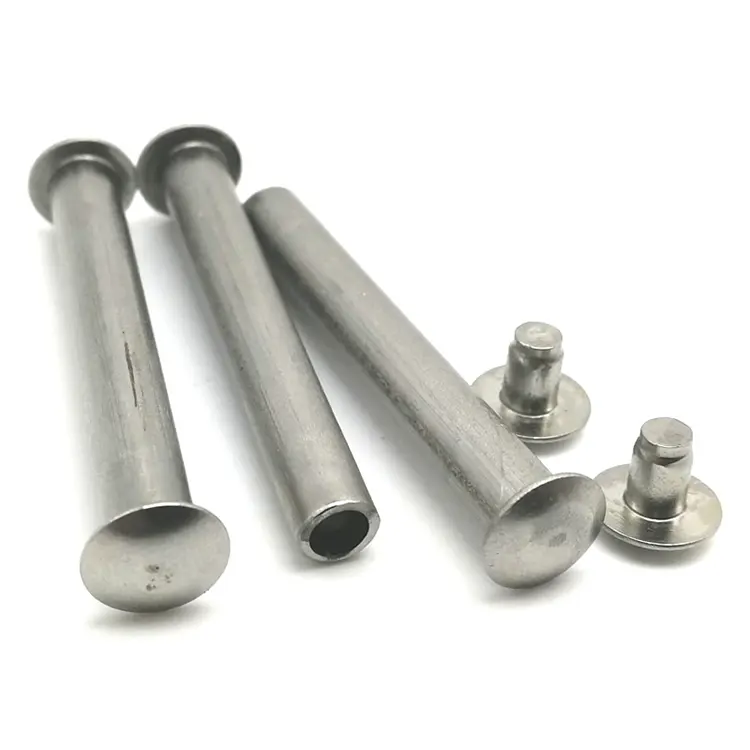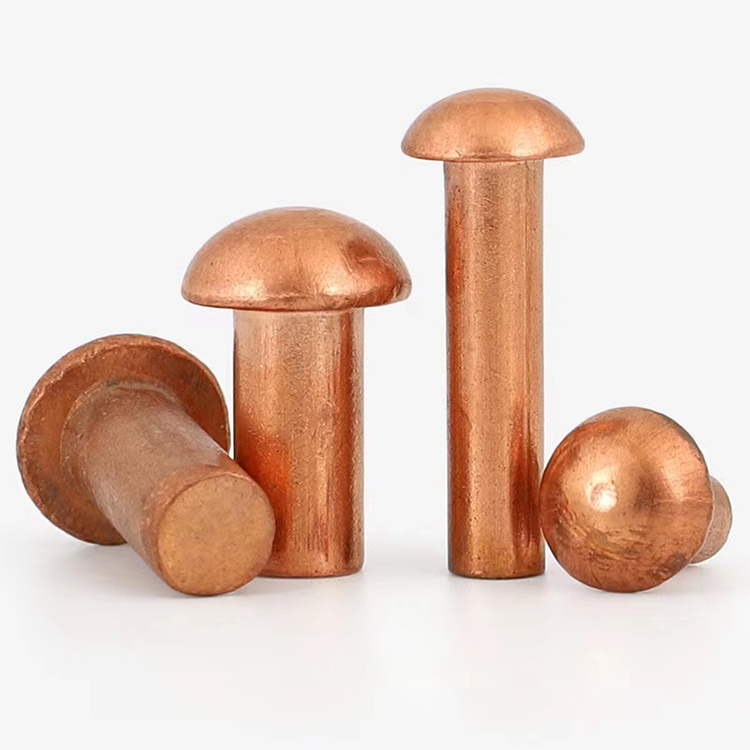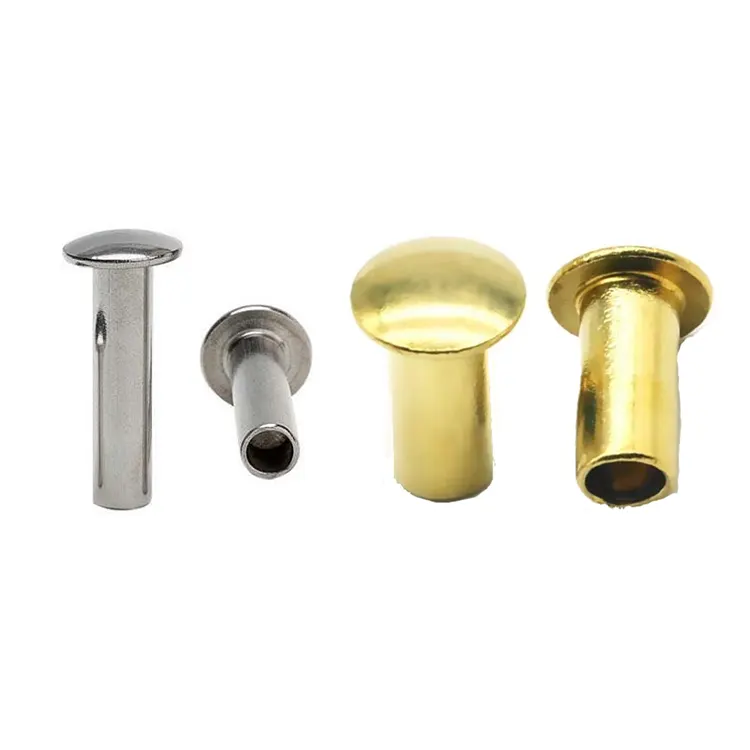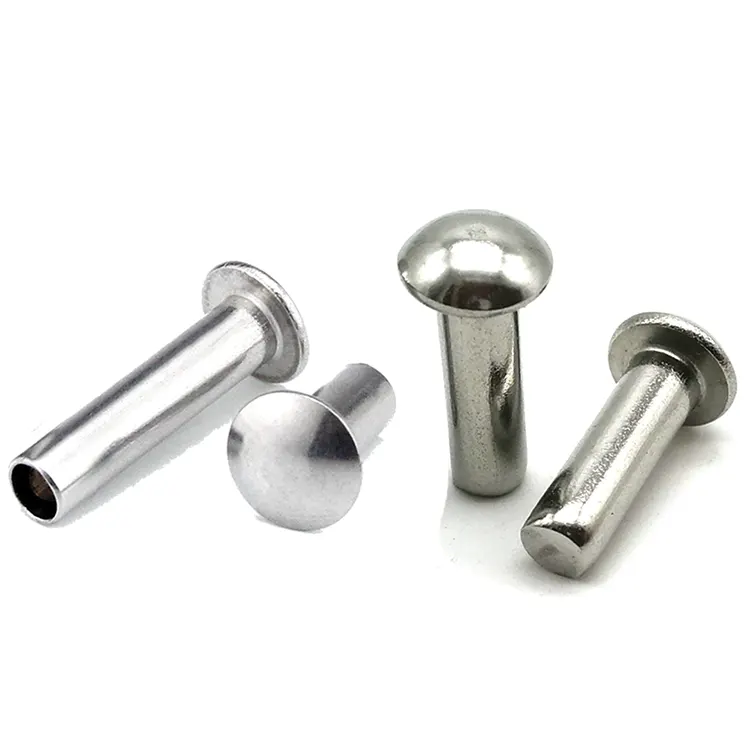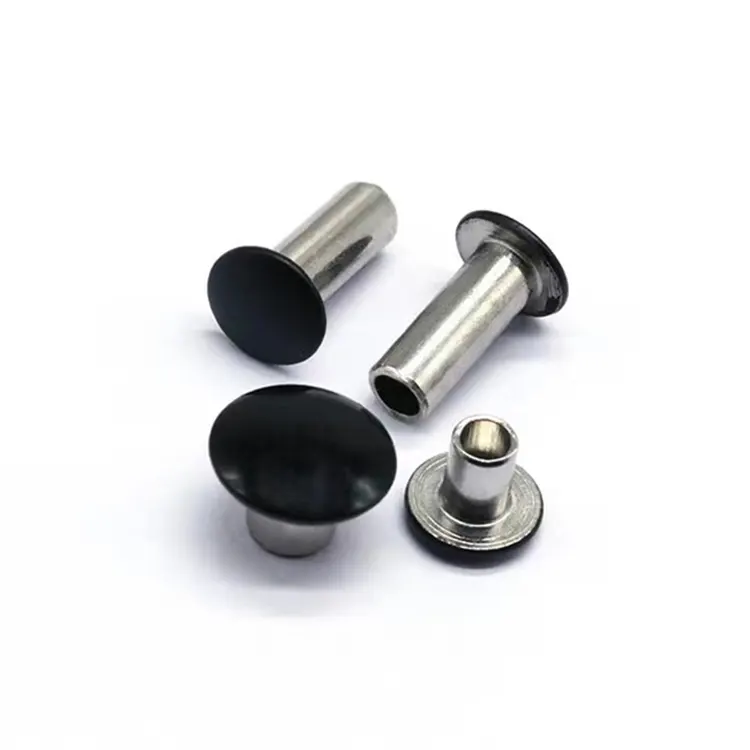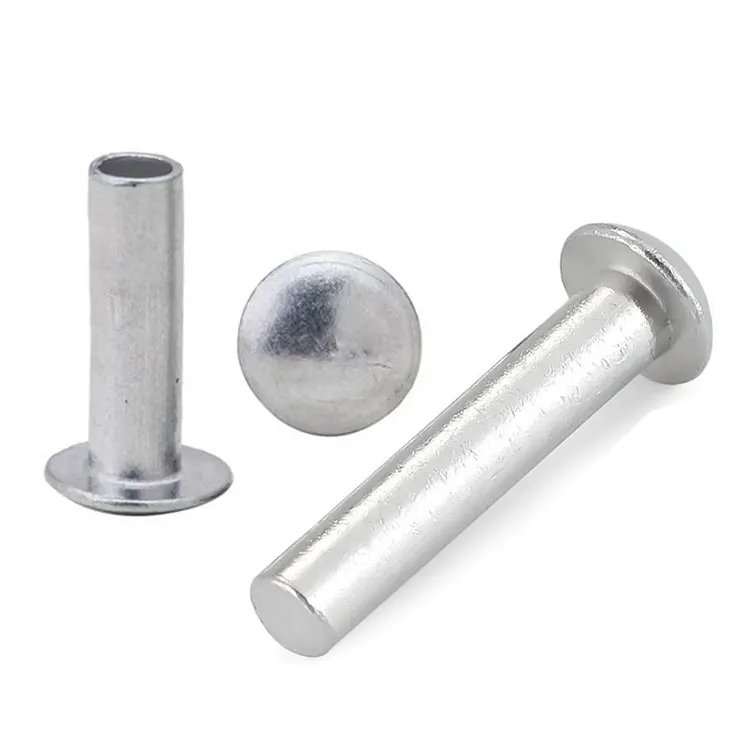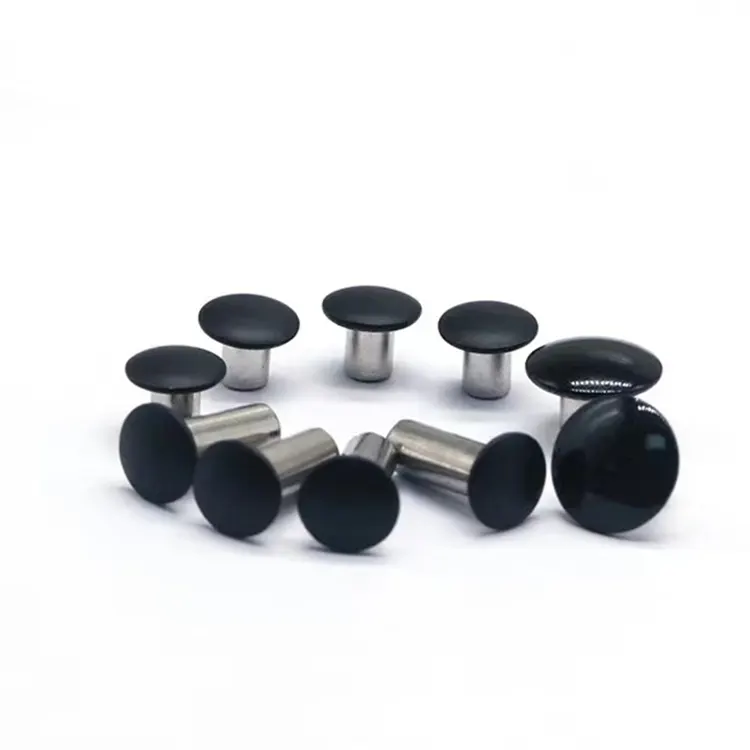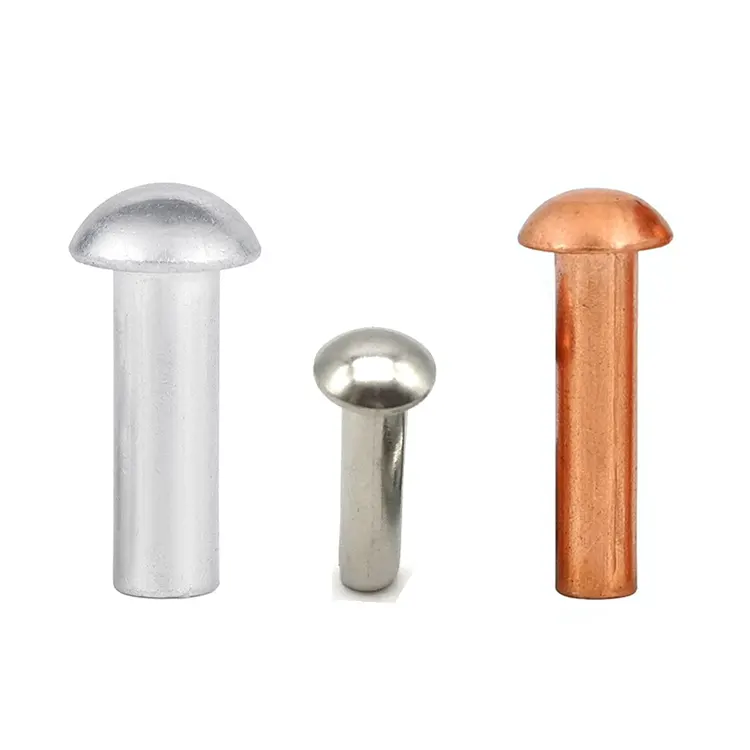Remaches
As one of professional manufacturer in China, Notin would like to provide you Rivets. And we will offer you the best after-sale service and timely delivery.
What is a rivet?
A rivet is a permanent mechanical fastener used to join two or more materials. Rivets work by inserting a metal pin into an aligned hole and deforming the end, creating a strong, secure, and durable connection. Unlike temporary fasteners like screws, rivets do not rely on threads, but instead form a permanent connection, making them ideal for applications requiring high strength, durability, and vibration resistance.
Classification of Rivets
Rivets are typically categorized by head shape, degree of hollowness, or material.
Based on head shape, rivets can be classified as flat head rivets, round head rivets, countersunk head rivets, mushroom head rivets, universal head rivets, truss head rivets, etc.

Based on degree of hollowness, rivets can be classified as solid rivets, semi-tubular rivets, or full tubular rivets.
Based on material, rivets can be classified as brass rivets, stainless steel rivets, steel rivets, aluminum rivets, copper rivets, etc.

What surface finishes are available for rivets?
Rivet surfaces are typically treated with rust-proofing treatments, primarily electroplating, including zinc plating, nickel plating, chrome plating, tin plating, gold plating, and silver plating. Electroplating is a common rust-proofing method for rivets. It applies a layer of plating to the rivet surface through physical or chemical methods. The plating effectively prevents corrosion and rust, while also providing a certain aesthetic effect.
Another special surface treatment method is head coating. Head coating is performed after the rivet is electroplated. This allows for a variety of colors on the rivet head, achieving an aesthetically pleasing finish.
Aluminum rivets cannot be electroplated, but they can be anodized. Anodizing also allows for a variety of color options, but the unit price is higher than electroplating.
Rust-proofing the rivet surface is crucial, effectively extending the rivet's service life and ensuring a secure connection. Different rust-proofing methods are suitable for different environments and applications, so the choice should be tailored to the specific situation.
- View as
Remaches semi huecos
Nuote Metals es un fabricante profesional de remaches ubicado en Dongguan, China, una ciudad industrialmente desarrollada con transporte conveniente y una amplia gama de tratamientos de superficie. Los remaches semihuecos son un elemento de fijación de uso común que se caracteriza por una sección hueca en el vástago. Este diseño les permite adaptarse mejor a la deformación de los materiales unidos durante el proceso de remachado, mejorando así la resistencia y confiabilidad de la unión. Los remaches semihuecos se utilizan ampliamente en las industrias de fabricación de automóviles, aviación y construcción naval, así como en el ensamblaje de productos electrónicos y electrodomésticos.
Leer másEnviar ConsultaRemaches de cabeza redonda
Los remaches de cabeza redonda presentan un diseño de cabeza único con una protuberancia semicircular. Esta estructura distribuye eficazmente la tensión cuando el remache se somete a fuerza, mejorando la estabilidad de la conexión. El cabezal elevado también facilita el posicionamiento y la alineación durante la instalación. Además, los remaches de cabeza redonda ofrecen una excelente resistencia a la corrosión y a la fatiga, manteniendo un rendimiento estable a lo largo del tiempo en entornos hostiles. ¿Busca remaches fabricados en China? No dude en ponerse en contacto con Nuote Metals, tenemos más de 10 años de experiencia laboral en remaches.
Leer másEnviar ConsultaRemaches con recubrimiento en polvo
Los remaches de colores, también conocidos como remaches con recubrimiento en polvo, se recubren con una capa de polvo en la cabeza del remache mediante un proceso de pintura por pulverización a alta temperatura. La pintura se seca uniformemente para garantizar un acabado que no se decolore. Este tipo de remache requiere un alto nivel de habilidad en el barnizado al horno y una combinación precisa de colores. Después del remachado, crea un color consistente y hermoso, realizando plenamente su efecto decorativo.
Leer másEnviar ConsultaRemaches de cabeza plana
Los remaches de cabeza plana son componentes mecánicos que se utilizan para sujetar o conectar materiales metálicos. Se utilizan ampliamente en la producción industrial, la fabricación de maquinaria, la reparación de automóviles y otros campos. La función de un remache es insertar el tubo del remache en las dos piezas de metal que se van a unir. La forma de la cabeza del remache y la sección del tubo comprimen el remache, creando una conexión hermética. Nuote Metals se especializa en la producción de remaches Pan Head. Disponemos de más de 40 máquinas de estampación en frío y miles de matrices, con una capacidad de producción diaria de hasta 10 millones de remaches. Damos la bienvenida a pedidos personalizados basados en sus dibujos y muestras.
Leer másEnviar ConsultaRemaches pintados
Los remaches pintados con cabeza pintada son muy resistentes a la corrosión. La capa de pintura, normalmente de 15 a 25 micrones de espesor, los aísla eficazmente de la humedad y los productos químicos. Las pruebas de niebla salina muestran que los remaches pintados pueden resistir la oxidación durante más de 500 horas, tres veces más que los remaches sin recubrimiento. Nuote Metals se especializa en este tipo de remaches, estamos ubicados en Dongguan, China.
Leer másEnviar ConsultaRemaches de cabeza de hongo
El nombre de remache con cabeza de hongo proviene de su apariencia y características estructurales. Un extremo del remache tiene forma de hongo y es relativamente ancho, lo que proporciona una mejor superficie de compresión y un mejor efecto estético. Los remaches semitubulares con cabeza de hongo tienen un diseño semihueco en el otro extremo. Durante la instalación, se utiliza una herramienta especial para expandir la porción hueca y formar una conexión segura. Este diseño permite que el remache se adapte a diferentes espesores de material después de la instalación, manteniendo al mismo tiempo una unión limpia y estéticamente agradable. También están disponibles remaches macizos con cabeza de hongo, que se remachan con tornillos para formar una cabeza en forma de hongo en el extremo trasero, creando una conexión estéticamente agradable y segura.
Leer másEnviar ConsultaWhat are the advantages of rivets over other fasteners?
1. Ease of Installation
Rivets are fast to install, and even fully automated for high-volume applications, resulting in a simple and efficient operation process.
2. Connection Reliability
The riveting process is standardized, with strict quality control, resulting in highly stable connections. Visual inspection allows for quick verification of connection quality.
3. Vibration and Impact Resistance
Rivets connect through deformation or interference fit, providing strong clamping force and excellent vibration resistance, capable of withstanding vibration and shock.
4. Low Cost
Rivets are easy to install and can be fully automated, saving significant labor costs.
What are the advantages and disadvantages of rivets made of different materials?
Aluminum Rivets
Advantages: Lightweight, reduces overall product weight, low cost, suitable for general civilian applications.
Disadvantages: Low tensile and shear strength, unsuitable for high-strength workpieces, prone to electrochemical corrosion when in contact with metals such as stainless steel.
Stainless Steel Rivets
Advantages: Strong corrosion resistance, high hardness, suitable for high-strength workpieces (such as marine equipment)
Disadvantages: Higher cost, typically more expensive than aluminum rivets of the same specification.
Brass and Copper Rivets
Advantages: Excellent conductivity (such as connecting electronic components), good corrosion resistance.
Disadvantages: Higher cost, more difficult to process.
Steel Rivets
Advantages: High hardness, high connection reliability, and wide applicability.
Disadvantages: Compared to other materials, iron rivets are more prone to rusting.
What are the main applications of rivets?
Rivets have a wide range of uses, from small items like a pair of scissors to large items like airplanes and ships, as well as in high-precision medical applications.
Industrial Manufacturing
Rivets are used in a wide variety of industrial fields, wherever there is a need to connect two or more materials.
Electronics
Rivets secure heat sinks and chips, providing both vibration damping and noise reduction, and are widely used in the cooling systems of electronic products such as computers and mobile phones.
Automotive
Rivets are widely used to connect components of automobile bodies and chassis, such as doors and hoods. Their lightweight and corrosion-resistant properties make them an indispensable joining method in automotive manufacturing.
Aerospace
In aircraft manufacturing, rivets are used to connect different fuselage components, such as wings and tailplanes. Millions of rivets create high-strength, corrosion-resistant joints. Aluminum and titanium alloy rivets are often used to connect components of corresponding materials, ensuring stability in extreme environments.
Rivets are used everywhere. The above examples only represent a small number of their applications. We see rivets everywhere in our daily lives, such as on scissors, folding beds, and strollers etc. Rivets can be customized to different sizes and materials depending on the application.
Nuote Metals has specialized in the rivet industry for over a decade. Our factory is located in Dongguan, a city known as the "World Factory," a city with a developed industry and convenient transportation. This allows us to respond quickly when acquiring raw materials and supporting surface treatments, meeting our customers' needs for quick access to samples and bulk orders. We produce 10 million rivets daily and have molds of various specifications, allowing us to produce rivets as small as 0.8mm and as large as 10mm. We welcome your inquiries and visits.

